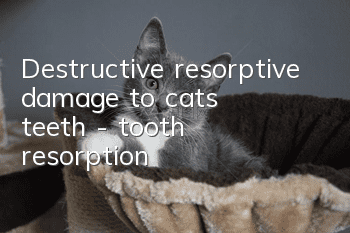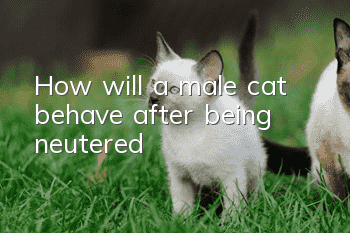Destructive resorptive damage to cats’ teeth - tooth resorption

Toothache and tooth decay are two completely different problems for humans and cats. Although cats are notorious for having bad teeth, they don’t get cavities like humans.
If we humans have tooth decay, it can usually be seen from the surface of the teeth. But this is not the case for cat “cavities”. Cat “cavities” will start above the gum line, and then gradually spread to the center of the pulp, from the inside out. Finally, in the severe stage, you may find it on the tooth surface. This type of "tooth decay" in cats is called "cat tooth destructive resorption damage", abbreviated in English as "FORLs". I usually refer to this disease as "tooth resorption". The acceptance rate in the hospital is very high, exceeding 50%. According to an incompletely accurate data, two-thirds of cats over five years old will be affected by tooth resorption at some stage in their lives.
As domestic cats live longer, these diseases are becoming more common.
01. What does tooth resorption look like
Teeth that have been eroded by tooth resorption usually appear at the edge of the gums, and the surface is eroded or resorbed. However, these diseased tissues are often covered by dental calculus or gingival hyperplasia (excessive gum tissue), so you may not be able to see them. Tooth resorption is a progressive disease, which means that it will develop faster and faster, and the condition will continue to worsen and become more serious. Usually the cementum and dentin are eroded first, and then penetrate into the pulp chamber. Immediately afterwards, tooth resorption will continue with the dentinal tubules into the crown of the tooth. Tooth enamel can also be eroded and even cause teeth to crack. The cementum and dentin are eventually replaced by bone-like tissue. Sometimes you can clearly see tooth resorption, but more often than not you need to take an X-ray to see it. Therefore, when it can usually be seen with the naked eye, it is already serious.
The teeth in the picture below, the third premolars, have tooth resorption problems, and gingival hyperplasia has occurred (see arrow).
02. Symptoms of tooth resorption
If your cat suffers from tooth resorption, it will be very painful, much more painful than when you have a toothache.
So the most direct problem is that the cat doesn’t like to eat.
There are some other more typical symptoms, which I will list one by one below. Typical symptoms include:
Bad breath
Popular in mouth
Too much saliva
Saliva smells bad
Eating behaviors include:
Loss of appetite
Cats may be very hungry, but they will drop things when they reach their mouth
Cats may stop eating because of too much pain and start to lose weight
Cats may be reluctant to drink water and become dehydrated
Other behaviors include:
Always scratching my mouth
I don’t want to play anymore
Lack of energy
When checking your mouth:
When it touches its mouth, it will bark and flinch
Infected teeth will become swollen and red
Teeth may become discolored
Gently pressing the infected tooth will cause extreme pain
The tooth may be cracked or broken
In addition, if there is a problem of tooth resorption, in addition to the oral cavity, other parts of the body may also be affected. Bacteria can enter the body through the blood circulation and infect other parts of the body. Includes:
Heart
Kidney
Intestine
joint
03. Causes, treatment, prognosis and prevention The exact cause of tooth resorption has always been a mystery.
We all know that when the disease begins, the cementum and other mineralized tissues of the tooth roots will be destroyed first. Damage to the gum tissue and irritation from periodontal tissue disease may be the cause. However, tooth resorption can also occur alone without any of the above symptoms! Some people speculate that increasing the vitamin D content in the diet will play a certain preventive role.
Dental resorption is usually assessed on a scale between 1 and 5 by professional veterinarians.
About the treatment plan, it will be decided according to the severity level. Generally speaking, tooth extraction is ultimately required to resolve the problem. If there is a problem with a cat's teeth, it is generally irreversible and cannot be repaired. Especially if the tooth is cracked and the root and neck are eroded, then the tooth can only be extracted. Antibiotics and painkillers will be supplemented during the treatment until the gums are fully restored.
For some relatively early stages of tooth resorption, some veterinarians may recommend taking alendronate sodium to relieve the disease and slow down the progression of the disease, but I personally do not recommend this administration. This medicine has very strong side effects and may do more harm than good.
Cats are very resilient animals. oneOnce the tooth extraction surgery is over, recovery is quick. One thing to mention here is that even if some cats have a mouth full of teeth, they will still eat well, because many times when they eat dry food or small pieces of meat, the cats will swallow it directly without chewing it.
Like gingivitis, so does tooth resorption. The older the cat, the more likely it is to suffer from the disease.
In addition, flat-faced breeds, as well as Siamese, seem to be more susceptible to oral diseases. But no matter what breed of cat, as long as prevention is done well, diseases will not come like a scourge. One thing to remember is that all dental diseases are progressive, so prevention must come first, supplemented by regular check-ups.
- What to do if a kitten vomits and foams
- Why are blue cat ears folded?
- How do novices choose Ragdoll cats? Things to note when choosing Ragdoll cats!
- What kind of shower gel is best for cats with severe hair loss?
- Things to note when bathing Himalayan cats
- What happens if you are bitten by a cat? What precautions should I take when getting vaccinated after being bitten by a cat?
- Can cats eat shredded squid? Will it cause gastrointestinal diseases?
- What should you do if cats often fight?
- In which months is cat shedding season?
- What can pregnant cats use to get rid of fleas?



